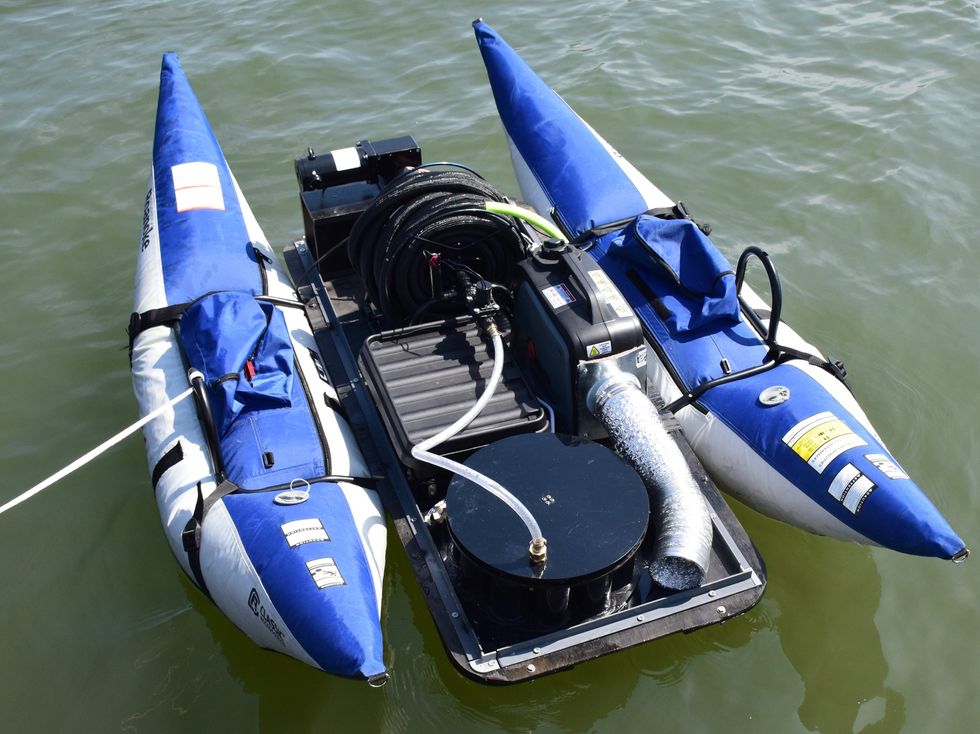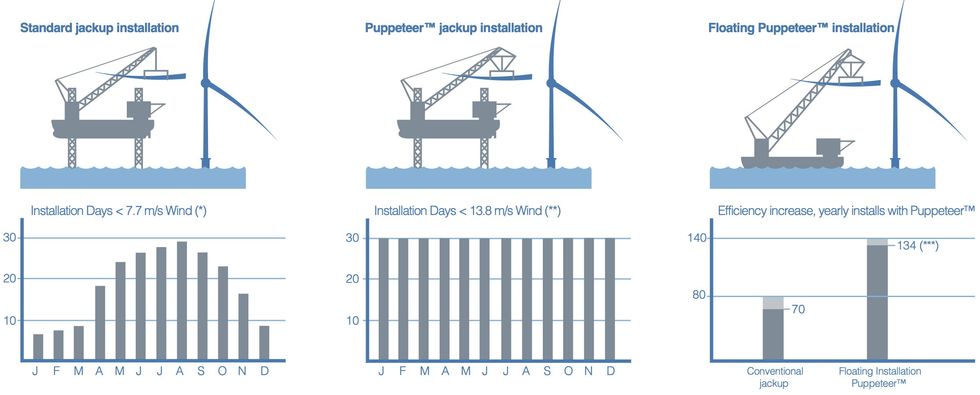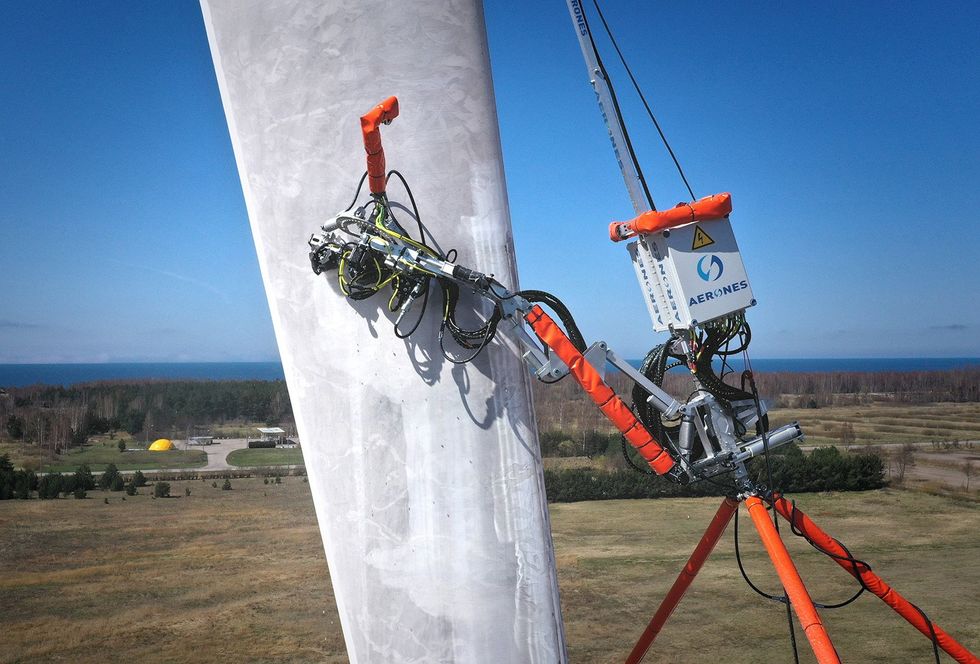How Roboticists Can Tackle Climate Change

The world emits 51 billion tonnes of greenhouse gases into the atmosphere every year. To solve the climate crisis, we need to cut this in half by 2030, and get to zero by 2050. For electricity generation, this means the United States alone needs to increase renewable-energy capacities by 10 times over the next 12 years, which roughly translates to a mind-boggling 400,000 more wind turbines and 2.5 billion more solar panels. To accelerate this progress, Congress has recently passed the Inflation Reduction Act, which includes billions of dollars for clean-energy projects. We will need a lot of workforce to install and maintain these facilities at the front lines, which are not always well suited to humans.
As a roboticist, I see these dull, dirty, and even dangerous tasks as the perfect area for robots. However, there's a shortage of roboticists tackling climate change, due to a lack of awareness of necessary and urgent applications. After talking with many climate robotics founders for my blog, Nirva Labs, here are my findings on how you can find opportunities to help robots make an impact on climate change.The first robot I built from scratch was SS MAPR, an autonomous boat for water departments to collect multidepth water-quality data. They use this data to monitor river pollution and rein in pollution sources. To this day, it remains the most exciting project I've ever worked on. After six months of 80-hour weeks and sleepless nights, SS MAPR was able to finish its maiden voyage with water samples and data collected from the bottom of the Schuylkill River, in Pennsylvania. That was the eureka moment for me: All the prototyping and coding resulted in faster and cheaper access to the data that drives regulatory actions. I want to build more robots that improve the environment we live in.
 SS MAPR prepares for its maiden voyage on the Schuylkill River, in Philadelphia.Sherry Chen
SS MAPR prepares for its maiden voyage on the Schuylkill River, in Philadelphia.Sherry Chen
Stunned by the rampant wildfires after moving to the Bay Area in 2020, I started Nirva Labs to write about climate robotics opportunities. Surprisingly, many founders I talked with echoed the shortage of roboticists in climate tech. This was disproportionate to the huge potential of robotics for solving climate problems. My personal experience confirmed those observations. At all the robotics events I went to in the Bay Area, one of the biggest robotics hubs in the world, I could barely find anyone working on climate. The investment data backed this up-according to PitchBook, climate robotics accounts for less than 1 percent of total robotics venture funding over the past five years.
Why aren't there more roboticists working on climate change? After talking to some peers, I realized that from a superficial perspective, climate change doesn't seem to need robotic inventions-we already have most of the solutions in nonrobotic forms. But that's exactly why climate change needs robotics to do the repetitive work: to scale up existing solutions so we can get to net zero in time.
Using robots to scale up existing climate solutionsTo understand why robotics is crucial for tackling climate change, we should look to an analogous case: the automotive industry. For a long time, cars were made by humans. In 1925, assembling one Ford Model T required an average assembly speed of 3.76 seconds per part. This was the norm for almost 40 years, before General Motors introduced a robotic arm to assist in the assembly line. Today, assembling a Toyota SUV takes about 2.04 seconds per part, a 46 percent improvement from a century ago-even though the assembly process has exploded in complexity.
This is the sweet spot for robotics-freeing humans from repetitive tasks while increasing efficiency. Climate tech is in a state similar to that of the early automotive industry. Most building blocks of the overall climate solution already exist (for example, solar- and wind-energy generators, electric vehicles, heat pumps) but need to be deployed at scale quickly in order to go from 51 billion tonnes of greenhouse gas emissions to net zero by 2050. By doing what they do best, robots can play a big role in accelerating the fight against climate change by enabling economies of scale.
Finding climate robotics opportunitiesThere are many technically feasible opportunities in climate robotics that can have an impact on the climate, but how do you actually find one? The best way is to deeply learn and understand the life cycle of an existing climate solution and identify how automation can accelerate it. But for any climate solution, it's important to watch out for its overall climate impact: is it directly mitigating or removing greenhouse gas emissions, helping us adapt to the impacts of climate change, or enhancing our understanding of the climate? The overall impact involves not only the technical solution but also the economic and political forces around it. So it's important to trace the solution down the entire life cycle and get a full picture of the pros and cons.
Climate robotics opportunities for renewable energyThe renewable-energy sector is a great place to search for climate robotics opportunities. Energy sources like solar and wind are already cost competitive compared with fossil fuel. Robots can help eliminate the bottlenecks that limit their expansion.
Starting from the source of the renewable-energy value chain, robots can help remove the labor bottleneck for installing solar and wind farms. For example, one of the most time-consuming and dangerous tasks in building solar farms is heavy lifting. AES, an energy giant, has developed an automated solar farm construction robot to solve this problem. The robot can automatically install solar panels on pre-installed foundations to free workers from lifting. It is also three times as fast as a human, and the new solar layout can generate twice as much solar energy within the same footprint. This is a great example of how outdoor autonomous navigation and robot manipulator control speeds up the renewable-energy transition.
 X Laboratory's motion-compensation technology helps to boost the number of days that wind turbines can be installed regardless of windy conditions. X Laboratory
X Laboratory's motion-compensation technology helps to boost the number of days that wind turbines can be installed regardless of windy conditions. X Laboratory
Offshore wind-farm construction faces a different challenge, with installations limited from April to November because the high wind conditions in the winter make it challenging for high-precision tasks such as blade installation. X Laboratory, a Dutch company, has developed a motion-compensation technology to keep a crane stable during the blade-installation process, which can increase the wind-speed tolerance and thus increase the installation days to all year round. The team is currently improving the technology to compensate for disturbances from waves, so installation can be done on floating vessels instead of jack-up vessels, which stand on the seabed. This could potentially double the construction speed. This is a creative and effective climate application of robust robot control.
Renewable-energy facilities need routine maintenance to stay efficient. With their rapid expansion over the past decade, there has been a shortage of skilled maintenance technicians. For example, inspecting and repairing onshore wind turbines involves hanging a person 150 meters above the ground, which can be done only by well-trained rope-access technicians. Many wind-farm operators have to hire technicians from out of state at a high cost, which pushes up the overall cost of wind energy.
Many companies have been using automation to solve this problem. Companies like Unleash are using drones to speed up blade inspection, while Aerones has developed a tethered drone supported by a rope system that has a bigger payload and better stability. This expands the task envelope from inspection to cleaning, coating, and simple repairs. Sometimes a creative spin on an existing robot brings a big impact.
 Aerones' tethered drones can assist with maintenance and inspection of wind turbines.Aerones
Aerones' tethered drones can assist with maintenance and inspection of wind turbines.Aerones
And there are many more robotics opportunities throughout the renewables value chain. Batteries are an important buffer for renewable energy, which varies throughout the day. However, there is a shortage of critical battery minerals like lithium and cobalt. Companies like Impossible Metals are working on robots to harvest ore nodules from the seabed to alleviate this shortage. On the other end of the battery life cycle, both academia (Oak Ridge National Laboratory) and industry (Posh Robotics) have been developing robots to repurpose retired EV batteries, which still have 80 percent storage capacity at the end of their lives and can be used as energy storage for buildings. Robotics speeds up the process and reduces human exposure to toxic chemicals and high voltage levels.
How You Can HelpStay up to date on the climate solutions landscapeFor a bird's-eye view of the existing solutions, How to Avoid a Climate Disaster by Bill Gates and Speed and Scale by John Doerr are both good books to start with. Project Drawdown has also compiled a comprehensive list of existing climate solutions and their estimated impacts. Stay up to date on climate news by following channels like InsideClimateNews. Join online climate communities such as Work on Climate to meet like-minded folks and learn about what they are working on.
Join a climate robotics research project or companyIf you want to contribute to solving climate change more directly, you can join an existing climate-robotics initiative. Climate Change AI is an active community of machine-learning (ML) researchers working on climate solutions. ClimateBase has a large climate-tech job board for those wanting to make a career transition. To discover more relevant projects and as a shameless plug, check out my blog, Nirva Labs, for coverage of climate-robotics founders and researchers. If you're more of a podcaster, Hardware to Save a Planet interviews people working on hardware solutions for climate change that aren't limited to robotics.
Start something on your ownIf you're ready to jump into the deep end, start a company or research project on your own! You can begin by reaching out to climate practitioners and asking them how to scale up the solutions they are working on. Try to fully understand their pain points before starting to build anything. If there's already a robotics solution for a certain vertical, don't just give up on it! Reach out to customers who are already using it and ask them how they want to improve it. Also ask customers who haven't started using it, and understand why. Usually there will be many different customer segments within a single vertical, which means that a better alternative or a differentiated solution will grab the remaining market share.
Climate change is the most pressing issue of our time, and we are running out of time. The Paris Agreement demands that we keep global warming to no more than 1.5 C (2.7 F). To achieve that goal, we must reduce our emissions by 45 percent by 2030 and reach net zero by 2050. But we are still far from that goal. Meanwhile, the Inflation Reduction Act has provided momentum for scaling up existing climate solutions to get to the carbon-reduction goal.
Roboticists, there's no better time to work on climate robotics than right now! We have the superpower that has taken us to Mars. Let's take advantage of this great policy environment and use our skills to accelerate climate solutions to reach net zero in time!
Sherry Chen is the founder of Nirva Labs, an organization that raises awareness about climate robotics solutions and encourages more engineers to join this field. She was also an early employee at Chef Robotics, building robots for repetitive tasks in commercial kitchens. Previously, she has built an award-winning autonomous boat for water-quality monitoring, taught a last-mile-delivery Nuro robot to interact safely with pedestrians, and published a paper on ML-based interactive planning for autonomous vehicles while doing research at the University of Pennsylvania.